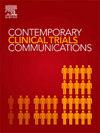Design and refinement of a clinical trial staffing model within the evolving landscape of oncology clinical trials
IF 1.4
Q4 MEDICINE, RESEARCH & EXPERIMENTAL
引用次数: 0
Abstract
Background
Quantifying workload for clinical trial staff represents an ongoing challenge for healthcare facilities conducting cancer clinical trials. We developed and evaluated a staffing model designed to meet this need.
Methods
To address individual protocol acuity, the model's algorithms include metrics to account for visit frequency, and the quantity, and types of research-related procedures. Since implementation in 2012, the model has been used to justify clinical research team resource needs and to establish metrics for leadership to reference when reviewing replacement positions; particularly useful to justify resources at the institutional level during the COVID-19 pandemic.
In recent years, we identified a gap between predicted and actual staff workload. This precipitated a comprehensive review in 2021 of all aspects of scoring within the model including a comparison to modern protocols to ensure accounting for all types of protocol-related procedures and tests.
Results
Further investigation identified increasing complexity of trial screening, which had not been accounted for in the initial model. Specifically, screening-related activities accounted for up to 25% of coordinator effort. We incorporated this work into the model and demonstrated a statistically significant change in average protocol acuity (P = 0.002) following refinement of scoring to include study-specific screening complexity.
Conclusion
Over the past decade, cancer clinical trial screening has increased in complexity and duration. Planning a cancer center's clinical trial workforce requires consideration of screening-related staff effort. For any effort model to be successful, ongoing examination and malleability are critical in this evolving landscape of clinical trials.
在肿瘤临床试验不断发展的环境中设计和改进临床试验人员配置模型
对开展癌症临床试验的医疗机构来说,量化临床试验人员的工作量是一项持续的挑战。我们开发并评估了一个人员配置模型,旨在满足这一需求。为了解决个人协议的敏锐性,该模型的算法包括访问频率、数量和研究相关程序类型的指标。自2012年实施以来,该模型已被用于证明临床研究团队的资源需求,并为领导层在审查替代职位时建立参考指标;在2019冠状病毒病大流行期间,这尤其有助于证明机构一级资源的合理性。近年来,我们发现预期工作量与实际工作量之间存在差距。这促成了2021年对该模型内评分的所有方面进行全面审查,包括与现代协议进行比较,以确保考虑到所有类型的协议相关程序和测试。结果进一步的调查发现,试验筛选的复杂性日益增加,这在最初的模型中没有考虑到。具体来说,与筛选相关的活动占协调员工作的25%。我们将这项工作纳入模型,并在细化评分以包括研究特定筛选复杂性后,证明了平均方案敏锐度的统计学显著变化(P = 0.002)。结论在过去的十年中,癌症临床试验筛查的复杂性和持续时间都有所增加。规划癌症中心的临床试验人员需要考虑与筛查相关的工作人员的努力。任何努力模式要取得成功,持续的检查和延展性在这个不断发展的临床试验领域是至关重要的。
本文章由计算机程序翻译,如有差异,请以英文原文为准。
求助全文
约1分钟内获得全文
求助全文
来源期刊

Contemporary Clinical Trials Communications
Pharmacology, Toxicology and Pharmaceutics-Pharmacology
CiteScore
2.70
自引率
6.70%
发文量
146
审稿时长
20 weeks
期刊介绍:
Contemporary Clinical Trials Communications is an international peer reviewed open access journal that publishes articles pertaining to all aspects of clinical trials, including, but not limited to, design, conduct, analysis, regulation and ethics. Manuscripts submitted should appeal to a readership drawn from a wide range of disciplines including medicine, life science, pharmaceutical science, biostatistics, epidemiology, computer science, management science, behavioral science, and bioethics. Contemporary Clinical Trials Communications is unique in that it is outside the confines of disease specifications, and it strives to increase the transparency of medical research and reduce publication bias by publishing scientifically valid original research findings irrespective of their perceived importance, significance or impact. Both randomized and non-randomized trials are within the scope of the Journal. Some common topics include trial design rationale and methods, operational methodologies and challenges, and positive and negative trial results. In addition to original research, the Journal also welcomes other types of communications including, but are not limited to, methodology reviews, perspectives and discussions. Through timely dissemination of advances in clinical trials, the goal of Contemporary Clinical Trials Communications is to serve as a platform to enhance the communication and collaboration within the global clinical trials community that ultimately advances this field of research for the benefit of patients.
 求助内容:
求助内容: 应助结果提醒方式:
应助结果提醒方式:


